Is the office making a return?
Many companies are now asking employees to return to the office, but this shift is not as dramatic as some of the headlines might suggest.
In this article, we break down what’s really happening with return-to-office (RTO) in 2025. From how many days people are actually going in, to what employees think about it (hint: not everyone’s thrilled), we look at the return to office data, challenges, and back-to-office trends.
So, here’s what you need to know:
Guide to return-to-office statistics
Key return-to-office statistics and trends
- 70% of companies now have formal RTO policies requiring some in-office time.
- 93% of business leaders believe employees should be in the office at least part of the week.
- 3 days per week is the most common in-office requirement.
- Fully flexible setups (remote or employee’s choice) dropped from 39% to 28% between 2023 and 2024.
- Only 7% of companies allow fully remote roles, down from 21% the year before.
- 44% of employees say they’d comply with a 5-day office mandate, 41% would job hunt, and 14% would quit.
- 48% of hybrid/remote workers would take an 8% pay cut to keep working remotely.
- 8 in 10 companies say they lost talent due to RTO policies.
Is the return to office (RTO) increasing?
Yes, return to office (RTO) is definitely on the rise — but it’s not quite as extreme as some headlines make it seem.
A 2024 survey by WTW found that over two-thirds of companies around the world now have official hybrid policies requiring employees to come into the office at least a few days a week. But here’s the catch: fewer than 5% of companies expect employees to be in the office five days a week.
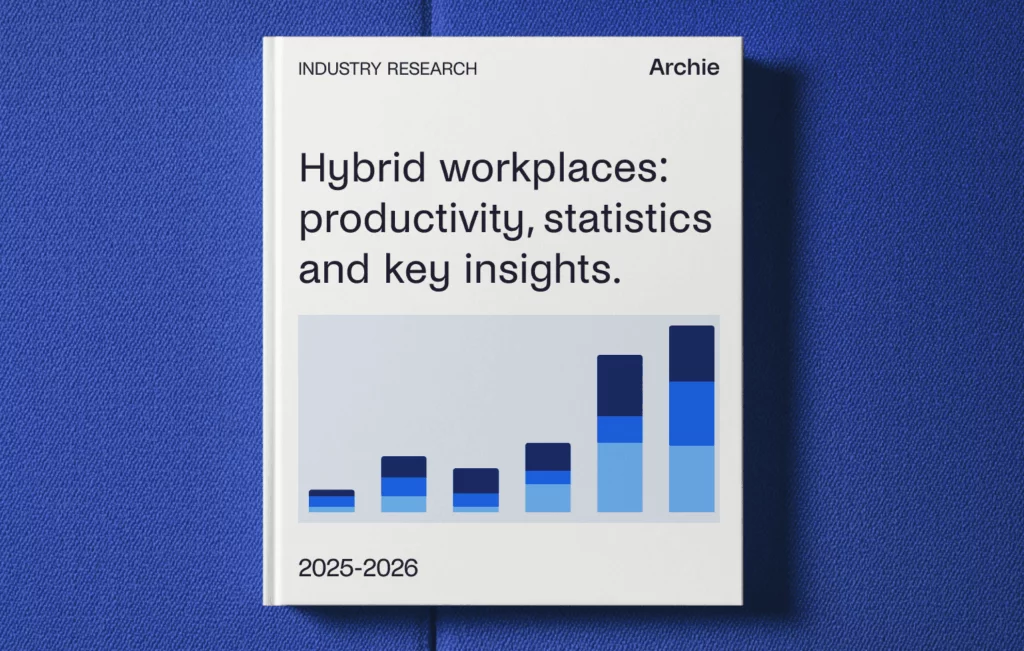
RTO mandates around the world
Most companies are still leaning into hybrid work models, where employees split time between home and the office. In fact, three days per week is now the most common in-office requirement, and over half of companies let employees choose which days they want to come in.
But the return to office looks different depending on where you are in the world.
A 2024 report from the Flex Index showed that 43% of U.S. companies now have set office schedules, which is more than double what it was in early 2023. Meanwhile, fully flexible work options have dropped to just 25%.
Another U.S. report from ResumeBuilder found that half of companies now ask employees to be in the office four or five days a week. And the trend is expected to continue — 70% of businesses say they’ll keep the same or increase office days this year, and 93% of business leaders believe employees should be in the office at least part of the week.
Office attendance also varies a lot by region, according to WTW. For example, in 2024:
- West Coast U.S. offices were only about 30% full,
- East Coast U.S. offices were closer to 50%,
- Europe averaged between 55% and 65%,
- Cities in Asia — like Hong Kong and Tokyo — saw much higher attendance, closer to 85–90%.
North American employees generally work remotely more than workers in Asia. Americans, for example, work from home about 1.4 days a week, while Japanese workers average just 0.5 days per week at home.
Fully remote jobs are also more common in North America, where about 20% of workers are fully remote. In comparison, Asia sees much lower rates — often under 10%. Europe falls somewhere in between, and countries like the Netherlands, France, and the UK have seen a strong rise in hybrid setups.
Even with many RTO companies supporting flexible work, they’re still trying to encourage more in-person time. Some do this by offering perks like commuter support, free lunches, or even bonuses. But not all companies are offering extra incentives — around 30% are asking people to return without any additional support.
The question remains, though:
Why are companies forcing the return to office in 2025?
First, many business leaders believe that in-person work helps teams work better together. According to a 2024 WTW survey, about 76% of company leaders think face-to-face time boosts employee engagement, 71% say it strengthens company culture, and 63% believe it helps people be more productive when they can collaborate in person.
At the same time, companies do recognize the value of remote work — and rightly so. That same WTW survey found that more than 80% of employers believe remote options help attract and keep talent, especially for roles that are hard to fill. They also found that workspace flexibility helps employees balance their work and personal lives, which leads to better engagement and retention.
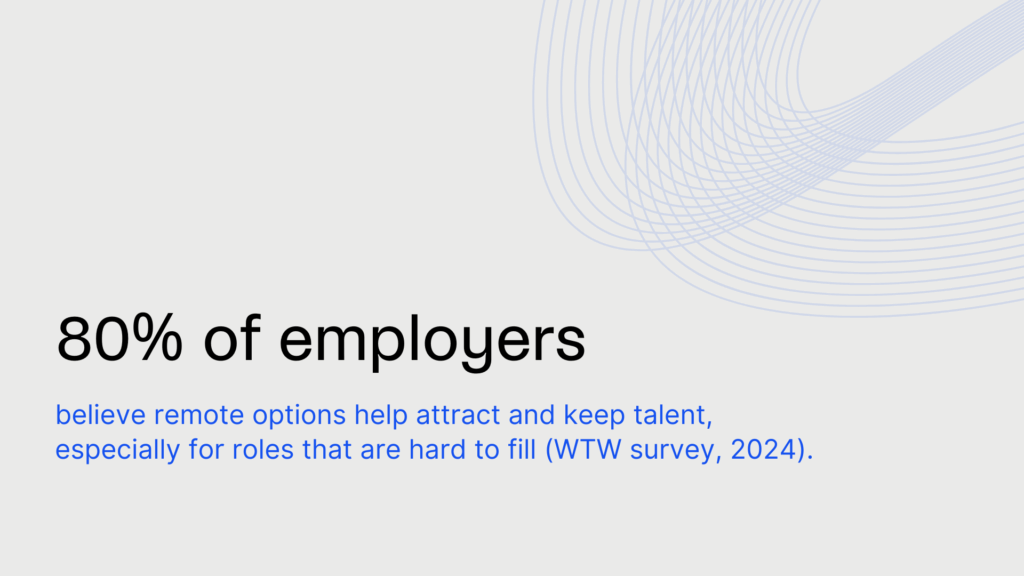
But not all motives are about teamwork. Unfortunately, some companies may be using RTO policies as a way to quietly reduce staff. A BambooHR study revealed that 1 in 4 executives (25%) and nearly 1 in 5 HR leaders (18%) admitted they were hoping some employees would quit when RTO policies were introduced. This kind of “quiet firing” allows companies to shrink their workforce without having to do formal layoffs.
Plus, some companies may also be pushing RTO to justify spending on office spaces or to help local businesses near their offices. With commercial real estate taking a hit in some cities, there’s pressure to show that these office spaces are still being used.
Others believe people might be more productive in the office — and more productivity usually means more profits. A 2024 study showed that companies in the S&P 500 were more likely to roll out RTO mandates after their stock prices dropped, hoping that bringing people back in would boost performance.
But does being in the office actually help? The research says… not really. There’s no solid proof that five-day office policies improve business performance, but there is strong evidence that they hurt employee satisfaction.
Who’s actually back in the office in 2025?
The year opened with some of the biggest companies returning to the office. Amazon, AT&T, Walmart, JPMorgan Chase, and Dell all pushed large groups of employees back to full-time office or close to it. The tone varied by company and region: Amazon paired a tougher U.S. stance with a bit more flexibility in places like the UK and the Netherlands, while Walmart wrapped its Bentonville campus relaunch in a broader relocation strategy that effectively ended many fully remote roles. Even when companies messaged culture and collaboration, the operational realities showed up fast: shortages of desks in cities like New York and Atlanta forced staggered timelines and made it clear that policy alone doesn’t create space.
Through spring, the trend settled into firmer hybrids. Google reinforced its three-day model for teams that had been fully remote, and Electronic Arts started phasing out full remote in favor of a consistent three-day cadence, with long notice periods for people living far from an office. Public employers joined in: Minnesota’s state government set an “at least half-time” threshold on site, signaling that local and state agencies are also recalibrating after years of flexibility. The story at this stage wasn’t a universal five-day return so much as a narrowing of the gap between what leaders wanted and what employees were actually doing.
September 2025 was the inflection point. A cluster of large organizations — Intel, BNY Mellon, Royal Bank of Canada, Ford, Bank of Montreal, Toyota, 3M, and parts of Target — moved from the familiar two- or three-day hybrid to four days a week in the office. That shift sounds small on paper, but it changes weekly rhythms in a big way: team rituals slide back toward Monday–Thursday in person, Fridays become the lone flexible day in many places, and commuting patterns start to look like the old normal with a modern twist.
Companies framed the change around speed, knowledge transfer, and cohesion — fewer hand-offs over chat, more shoulder-to-shoulder work, and faster decisions. Employees, meanwhile, raised the expected concerns about commute time, costs, childcare, and the uneven value of certain office days when meetings or teammates still span time zones.
October brought fresh, high-profile updates and a more explicit “lead by example” tone. HSBC set a four-day in-office requirement for managing directors and signaled it may extend stricter rules to more staff. Starbucks moved corporate hubs in Seattle and Toronto to four defined days, complete with “common days” to get everyone aligned and a relocation requirement for people managers who live outside those cities. Samsung went further for parts of its U.S. semiconductor business, enforcing five days on site and rolling out attendance tools to curb “coffee badging.” The message from these moves is less about symbolism and more about consistency: leaders want predictable overlap, visible mentorship, and a clear sense of who is actually in the building on any given day.
Not every organization flipped the switch in 2025. Several well-known names have announced 2026 timelines instead, giving themselves room to expand space, tune policies, and pace change with local labor markets. These longer runways suggest leaders are weighing real estate capacity, hiring markets, and the risk of turnover alongside cultural goals.
Across all of these examples, a few themes stand out:
- First, hybrid remains the default in 2025, but the center of gravity has shifted from two or three days to four for many large employers.
- Second, the companies that moved fastest often ran into practical challenges: think desk shortages, seating plans, and the simple math of fitting more people into the same footprint.
- Third, employee sentiment continues to hinge on the quality of in-office time. When a day in the office delivers hands-on learning, faster unblockers, and real collaboration, people tend to accept it more readily. When it feels like remote work done from a different chair, pushback grows.
- Finally, the most durable rollouts have been phased, clearly explained, and supported by better hybrid office management tools and spaces, rather than driven only by policy memos.
How do employees feel about RTO?
In short? A lot of employees aren’t thrilled about being asked to go back to the office full-time, and many are actively pushing back.
According to Gartner, nearly three-quarters of HR leaders say RTO mandates have caused tension inside their organizations. When companies like Amazon and Dell pushed for stricter office mandates in 2024, many workers began looking for new jobs. Some, especially senior leaders, actually left for competitors who offered more flexible options.
The WFH Research group, led by Stanford economists, found that by the end of 2024, only 44% of workers said they’d comply with a five-day RTO policy. A growing number — 41% — said they’d look for another job, and 14% said they’d outright quit. This shows that forcing people back full-time can backfire, especially with employees who’ve built their lives around more flexible work.
Most employees prefer remote work
According to a BambooHR survey from mid-2024, more than half of full-time U.S. workers (52%) said they prefer to work remotely, while only 39% said they prefer being in the office. Research from Gartner also shows that remote workers often feel more included and productive than when they’re in the office full-time. In fact, most employees say they do their best work from home.
For most, it’s all about flexibility and work-life balance — less commuting, more time with family, and being able to manage their day better.
Many would quit if forced back full-time
A Pew Research study found that 46% of remote-capable workers in the U.S. said they’d be unlikely to stay at their job if remote work ended, with 26% saying they’d be very unlikely to stick around. A WTW global survey backed this up, showing 53% of remote workers would look for a new job within a year if forced to return full-time to the office.
Then, a Gartner survey found that 1 in 3 executives would consider quitting if forced back to the office full time. So this is something people at every level are thinking about.
People would even take a pay cut
That’s how important flexibility is — nearly half of hybrid and remote workers (48%) said they’d take an 8% pay cut to keep working from home.
The pressure to “look busy”
A BambooHR survey shows that many people feel the need to prove they’re working, whether working remotely or in the office.
- 88% of remote workers and 79% of in-office workers say they go out of their way to show they’re being productive.
- Many remote workers admit to keeping their status “green” on chat apps all day — even when they’re not working — just to seem active.
- In the office, people say they walk around or chat with others just to be seen by their boss.
This shows that trust is a big issue — workers feel they’re being judged more on visibility than actual results.
Caregivers and disabled workers depend on flexibility
The same survey proves that remote work isn’t just a perk — for some, it’s essential:
- 75% of parents and caregivers say flexibility helps them balance work and home life.
- And 63% of workers with disabilities prefer working remotely, with many saying they’d consider leaving if forced to return to the office.
There are some challenges, too
At the same time, hybrid and in-office teams are facing a new challenge: feeling disconnected from their remote coworkers. A BambooHR report found that over 40% of hybrid employees feel less connected to teammates who don’t come in as often. This “in-office vs. remote” divide can affect teamwork and morale if not handled well.
While hybrid work has a lot of perks, it’s not perfect. One issue that’s come up is that some in-office and hybrid workers feel disconnected from teammates who work remotely. A BambooHR report found that over 40% of hybrid employees said they don’t feel as connected to coworkers who aren’t in the office much. If companies don’t find ways to bridge that gap, it can hurt teamwork and make people feel left out.
At JPMorgan Chase, returning to the office full-time has been tough for many employees. According to Fortune, workers have run into problems like not enough desks and meeting rooms, slow or unreliable Wi-Fi, and crowded offices.
In fact, less than half of employers (47%) and employees (42%) globally feel that their office spaces are well-equipped to support the evolving needs of hybrid work. Some of these issues can be addressed with hybrid office software like Archie, though.
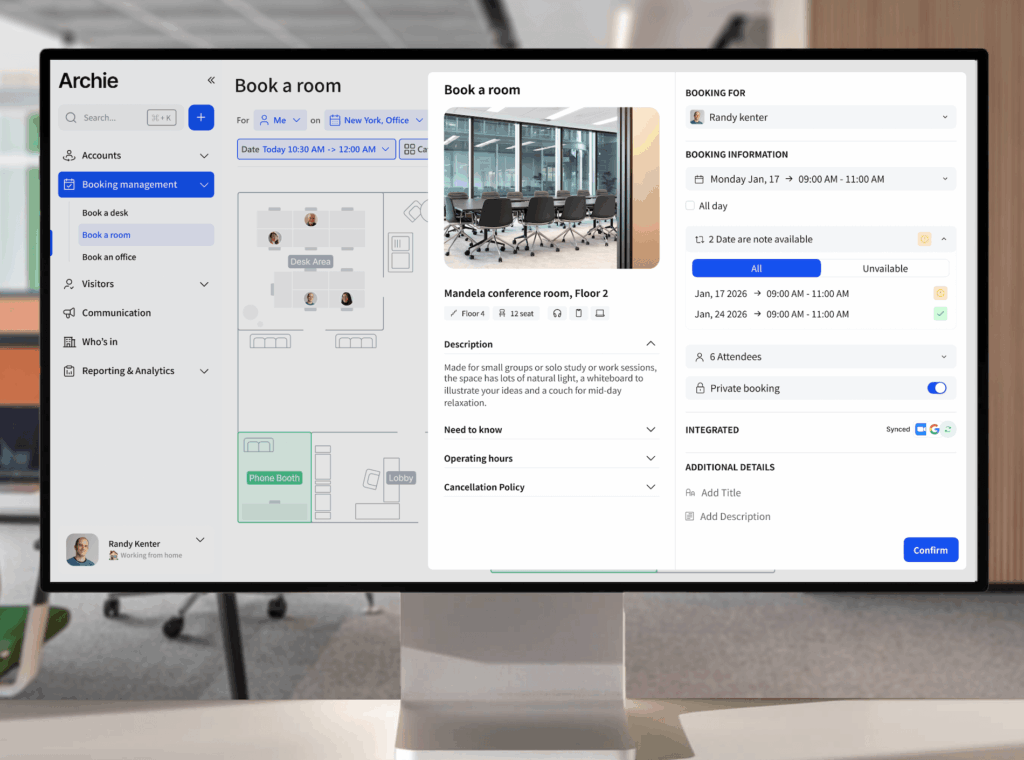
The attendance gap is finally narrowing
According to CBRE, employers in the Americas now expect about 3.2 days in the office, and employees are showing up about 2.9 days. Seventy-two percent of companies say they’re actually hitting their attendance goals, up from 61% last year, and more than a third still expect further gains. The biggest struggle is scale: very large companies report the widest gap between what they ask for and what they get, while small companies show almost no gap at all.
Eighty-five percent of companies now communicate an attendance policy, 69% measure compliance (up from 45% in 2024), and 37% are taking enforcement actions (up from 17%). That tougher stance helps explain why more firms feel they’re at “steady state.” Even so, the “hybrid dilemma” remains: offices are near capacity on peak days for 73% of companies, but only 34% say they’re at capacity on an average day. In fact, two-thirds report their space is under 60% utilized on a typical day, which hurts energy and culture mid-week.
Seating strategies keep shifting to combat desk shortages
Assigned seating is falling fast (only 25% rely on it today, down from 40% in 2024 and 56% in 2023) because part-time attendance makes 1:1 seats wasteful. Desk sharing is the norm and getting bolder: by 2027, 73% expect people-to-desk ratios above 1.5:1.
Flex space also remains part of the toolkit. Most firms still keep it under a quarter of the portfolio, but they’re growing usage to reduce capex, hedge uncertain demand, and give teams on-demand meeting space. Small companies lean into flex to give employees more choice; large companies use it more as a financial and capacity lever.
Is return to office worth it?
Return to office is worth it… Sometimes. Being in the office can build energy, help with collaboration, and make some tasks easier. But when companies force it, without listening to what employees want or need, it often backfires.
According to the ResumeBuilder survey, 8 in 10 companies admitted to losing talent because of their RTO policies. Another survey from ZipRecruiter found that businesses with tough RTO policies had turnover rates about 13% higher than those with more flexible setups (169% vs. 149%). And companies with strict mandates were twice as likely to say their turnover had gone up in the past year.
Some employees simply aren’t willing to move back near the office or give up the flexibility they’ve grown used to. Others have family or health needs that make remote work a better fit. In fact, companies that offer remote or hybrid work tend to retain more talent. According to ZipRecruiter, employers that expanded remote options were more likely to be growing and hiring.
The best results come from a flexible and thoughtful approach, not rigid rules. People want to feel like they have a say — and that their time in the office actually matters.
In fact, 41% of workers say they’d be more willing to return to the office if it came with higher pay. Other things that make office life more appealing include a shorter commute (28%), no dress code (23%), and better technology (18%).
So instead of forcing people back, companies should consider:
- Involving employees in setting hybrid schedules
- Explaining why office time is important (like for team projects or collaboration)
- Using office time wisely — for brainstorms, planning sessions, or social events
- Investing in hybrid office tools to make things easier
Beyond internal planning, enriched data can also support business growth. For instance, combining workspace analytics with CRM enrichment helps companies build fuller profiles of their prospects and customers. That way, the same insights that make hybrid policies more effective can also power more personalized outreach and lead generation.
The issue is: With 87% of workers now saying that great technology is essential to their job (up from 83% in 2023), choosing the right tools is more important than ever.
If your company runs on a hybrid work model, Archie is the all-in-one tool you need to keep your office running smoothly. It helps employees book desks, reserve meeting rooms, check in visitors, and track office usage — all in one place.
Unlike other tools that charge per user, Archie charges per resource, like desks or meeting rooms. That makes it perfect for flexible teams where you might have more employees than office space. You only pay for what you use.
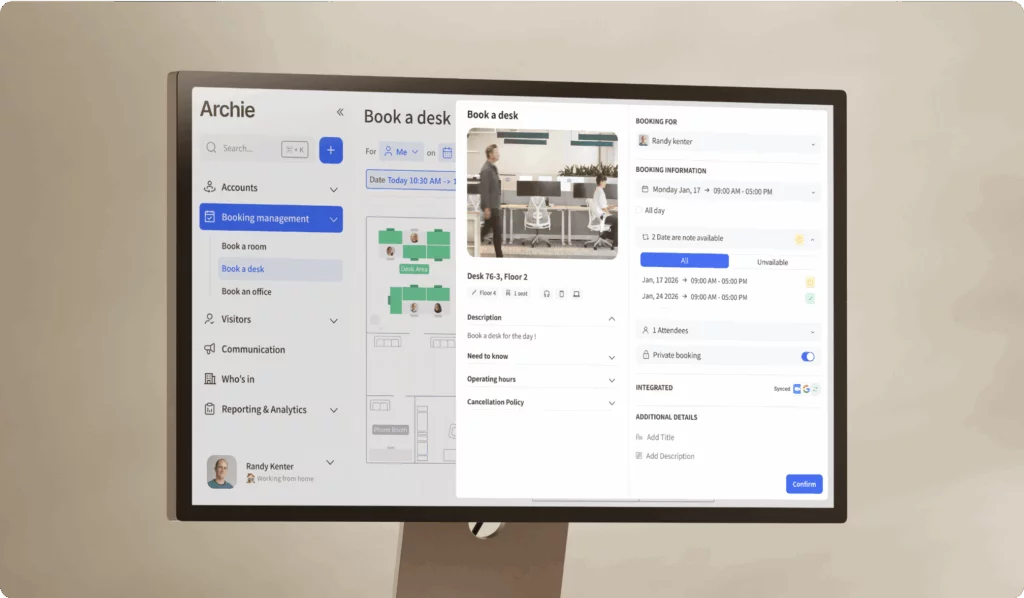
Back to office trends in 2025
Are more companies returning to office? Well, some big companies are still trying to get everyone back into the office full-time, but it’s not going as smoothly as they’d hoped. These strict rules have led to more people quitting, drops in productivity, and less trust between employees and leadership.
In 2025, we’re seeing the workplace shift in a different direction. Hybrid work is still going strong, but it’s becoming more thoughtful and flexible. In fact, one of the biggest trends this year is customizing work setups. Instead of using the same schedule for everyone, companies are learning that giving people more say in when and where they work leads to better results. That could mean coming into the office for team meetings or creative sessions, while using quiet time at home to focus on deep work.
Smaller companies and startups are leading the way, especially in tech, insurance, and finance. According to Forbes, nearly 70% of small companies (under 500 employees) still let their teams work fully remotely if they choose. On the other hand, more traditional industries like hospitality, education, and transportation tend to expect full-time office attendance.
No matter what the future holds, one thing is certain. When companies take the people-first approach when building their hybrid & RTO policies, it builds trust, improves teamwork, boosts productivity, and helps keep great employees around. That’s what makes return to office actually worth it — for everyone.
A summary of the most recent RTO statistics
🔄 Return-to-office stats on trends & policies
- Over two-thirds of companies globally now have formal RTO policies requiring some in-office time (WTW, 2024).
- Fewer than 5% of companies require employees to be in the office 5 days a week (WTW, 2024).
- Three days per week is the most common in-office requirement (WTW, 2024).
- Over 50% of companies let employees choose which days they come in (WTW, 2024).
- 43% of U.S. companies had set office schedules by late 2024 — up from 20% in early 2023 (Flex Index, 2024).
- Fully flexible work options dropped to 25% by late 2024 (Flex Index, 2024).
- 50% of companies require employees to be in the office 4 or 5 days a week (ResumeBuilder, 2024).
- 70% plan to maintain or increase office days in 2025 (ResumeBuilder, 2024).
- 93% of business leaders believe employees should be in the office at least part-time (ResumeBuilder, 2024).
- Only 7% of companies allowed fully remote office-based roles in 2024 — down from 21% in 2023 (ZipRecruiter, 2024).
- Fully flexible setups dropped from 39% (2023) to 28% (2024), while hybrid setups rose from 37% to 53% (ZipRecruiter, 2024).
- The share of firms requiring a full 5-day office week increased from 16% to 20% (ZipRecruiter, 2024).
- Employers expect 3.2 in-office days/week; employees average 2.9 (CBRE, 2025).
- 72% say they’re meeting attendance goals (up from 61% last year). More than 1/3 expect further attendance gains (CBRE, 2025).
- 85% have a communicated attendance policy (CBRE, 2025).
- 69% measure compliance, up from 45% in 2024 (CBRE, 2025).
- 37% take enforcement actions, up from 17% in 2024 (CBRE, 2025).
🌍 Regional differences in office attendance
- West Coast U.S.: ~30% office occupancy (WTW, 2024).
- East Coast U.S.: ~50% (WTW, 2024).
- Europe: ~55–65% (WTW, 2024).
- Asia (e.g., Hong Kong, Tokyo): ~85–90% (WTW, 2024).
👔 Why companies want RTO
- 76% of leaders say face-to-face work boosts engagement (WTW, 2024).
- 71% say it strengthens company culture (WTW, 2024).
- 63% say it improves productivity (WTW, 2024).
- Over 80% say remote work helps attract and retain talent (WTW, 2024).
💼 Employee feelings about RTO
- Only 44% of workers said they’d comply with a 5-day RTO policy (WFH Research, 2024).
- 41% said they’d look for a new job (WFH Research, 2024).
- 14% said they’d quit (WFH Research, 2024).
- 52% of full-time U.S. workers prefer remote work (BambooHR, 2024),
- Only 39% prefer the office (BambooHR, 2024).
- 46% of remote-capable workers say they’d likely leave their job if remote work ended (Pew Research, 2024–25).
- 26% say they’d be very unlikely to stay (Pew Research, 2024–25).
- 53% of remote workers would look for a new job if forced back full-time (WTW, 2024).
- 1 in 3 executives would consider quitting if forced back full-time (Gartner, 2024).
- 48% of hybrid/remote workers would take an 8% pay cut to keep working remotely (WTW, 2024).
🧠 RTO stats on employee behaviors & challenges
- 88% of remote workers and 79% of in-office workers feel they need to prove they’re being productive (BambooHR, 2024).
- 64% of remote workers keep their chat app status green, even when not working (BambooHR, 2024).
- 75% of caregivers say flexibility helps them manage work and home (BambooHR, 2024).
- 63% of workers with disabilities prefer working remotely (BambooHR, 2024).
- 42% of workers with disabilities would consider leaving if forced back (BambooHR, 2024).
- Over 40% of hybrid employees feel disconnected from fully remote teammates (BambooHR, 2024).
- On peak days, 73% say offices are at/near capacity (CBRE, 2025).
🏢 Office setup challenges
- Assigned seating used by 25% of companies today, down from 40% in 2024 and 56% in 2023 (CBRE, 2025).
- By 2027, 73% expect people-to-desk ratios >1.5:1 (CBRE, 2025).
- Only 47% of employers and 42% of employees feel their office is equipped to support hybrid work needs (BambooHR, 2024).
- 8 in 10 companies admitted they lost talent due to RTO mandates (ResumeBuilder, 2024).
- Companies with strict RTO had 13% higher turnover (169% vs. 149%) (ZipRecruiter, 2024).
- Companies with strict RTO were twice as likely to say turnover had increased (ZipRecruiter, 2024).
- 41% of employees said higher pay would make them more open to returning to the office (Owl Labs, 2024).
- Other top reasons to return: 28%: shorter commute, 23%: no dress code, 18%: better technology (Owl Labs, 2024).
- 87% of workers say great technology is essential to their job (Owl Labs, 2024).
Sources
- Gartner, The Data Is In: Return-to-Office Mandates Aren’t Worth the Talent Risks
- WFH Research — Barrero, Jose Maria, Nicholas Bloom, and Steven J. Davis, Why working from home will stick
- David Van Dijcke, Florian Gunsilius, and Austin Wright, Return to Office and the Tenure Distribution
- Prithwiraj Choudhury, Tarun Khanna, Christos A. Makridis, Kyle Schirmann, Is Hybrid Work the Best of Both Worlds? Evidence from a Field Experiment
- ResumeBuilder, 1 in 4 Companies Plan to Increase Required Days in Office.
- Fortune 500 Flex Index Report
- BambooHR, Return to Office Data Story
- Forbes, An Update on Return-to-Office Policies as We Enter 2025
- WTW, Flexible Work Models Pulse Survey
- Pew Research Center, Survey of U.S. workers
- ZipRecruiter, Annual Employer Survey
- WTW, Dynamics of Work Survey
- Yuye Ding, Zhao Jin, Mark (Shuai) Ma, Betty (Bin) Xing, Yucheng (John) Yang, Return to Office Mandates and Brain Drain
- Owl Labs, State of Hybrid Work Report
- CBRE, 2025 Americas Office Occupier Sentiment Survey
- Archie, Hybrid Work Statistics in 2025: Productivity & Preferences.
- Archie, Companies Returning to Office: 2025 RTO Tracker

Berenika Teter
Archie's Content Manager, fueled by filter coffee and a love for remote work. When she’s not writing about coworking spaces and hybrid workplaces, you can probably find her exploring one.






















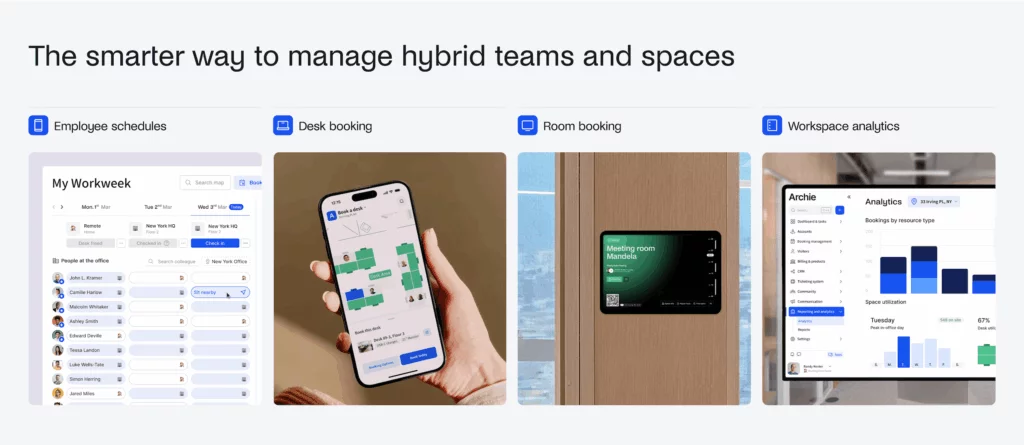


![Work Meetings in Numbers: Latest Meeting Statistics [2026] Four professionals in a glass-walled meeting room having a discussion, with city views in the background.](https://archieapp.co/blog/wp-content/uploads/2025/08/Latest-meeting-statistics-cover-image-400x400.jpg)